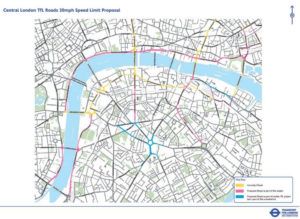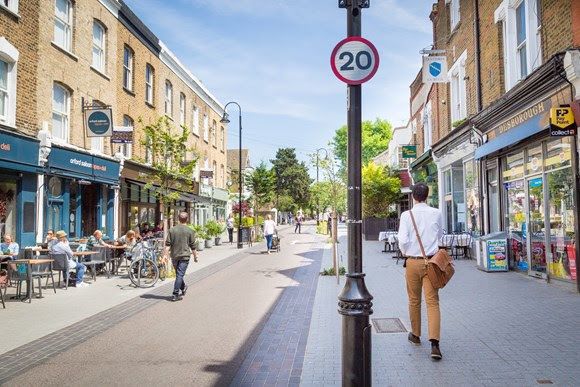Transport for London (TfL) has announced that proposals to lower speed limits across central London will go ahead, following a positive response to its public consultation earlier in the year, with a new 20mph (32km/h) limit introduced on 5.5 miles (8.9km) of its roads.
TfL will drop the current 30mph (48km/h) limit by 10mph (16km/h) on all its roads in the Congestion Charge Zone (CCZ) by early 2020, mirroring the lower speed limits already in place on the majority of borough-operated roads in the central London area. The lower speed limit will be supported by new 20mph signage and road markings, as well as raised pedestrian crossings in seven locations where a high number of people walk. TfL will recalibrate all speed cameras in central London and use mobile speed cameras to ensure that drivers are complying with the new safer speed limit.
There were nearly 2,000 responses to the public consultation, with half of respondents saying the plans would have a positive impact on walking and 31% saying that many more people would choose to walk. Almost two-thirds thought that the proposals would lead to more people cycling (59%) and 40% thought that the proposals would have a positive impact on public transport. Additional comments were in support of making the streets safer, as well as more pleasant and welcoming, and encouraging more people out of their cars to walk, cycle and use public transport, and improve driver behavior.
 Over the next five years, TfL will work with London boroughs and the public to introduce lower speed limits on its road network, reducing road danger and the number of people being killed and seriously injured in speed-related collisions. Figures from 2016, 2017 and 2018 (provisional) suggest 128 people were killed in speed-related collisions on London’s streets. A further 2,256 people were reported as seriously injured in collisions where speed was recorded as a contributory factor. Cutting speeds from 30mph to 20mph significantly reduces the likelihood and severities of these collisions. People walking are particularly vulnerable to speeding vehicles and 52 pedestrians have already died this year, compared to 56 in the whole of 2018.
Over the next five years, TfL will work with London boroughs and the public to introduce lower speed limits on its road network, reducing road danger and the number of people being killed and seriously injured in speed-related collisions. Figures from 2016, 2017 and 2018 (provisional) suggest 128 people were killed in speed-related collisions on London’s streets. A further 2,256 people were reported as seriously injured in collisions where speed was recorded as a contributory factor. Cutting speeds from 30mph to 20mph significantly reduces the likelihood and severities of these collisions. People walking are particularly vulnerable to speeding vehicles and 52 pedestrians have already died this year, compared to 56 in the whole of 2018.
TfL says lower speeds, as well as safer junctions, will help to address this, and aims to introduce new limits across 93 miles (150km) of its road network, focusing on high-risk sections and town centers where people walk and cycle, combined with local speed reduction programs led by London boroughs. To support this, TfL has published a Lower Speeds Toolkit, which is designed to help engineers and designers make London’s streets safer for everyone, such as installing chicanes and virtual speed humps, and reallocating space for walking and cycling.
“We know that lower speeds save lives; it’s that simple. As more and more people choose to walk and cycle around London, we must reduce the risk of them being killed or seriously injured,” noted Penny Rees, TfL’s head of network sponsorship. “It’s clear people agree that making our roads safer will encourage Londoners to travel in more active and sustainable ways.”





